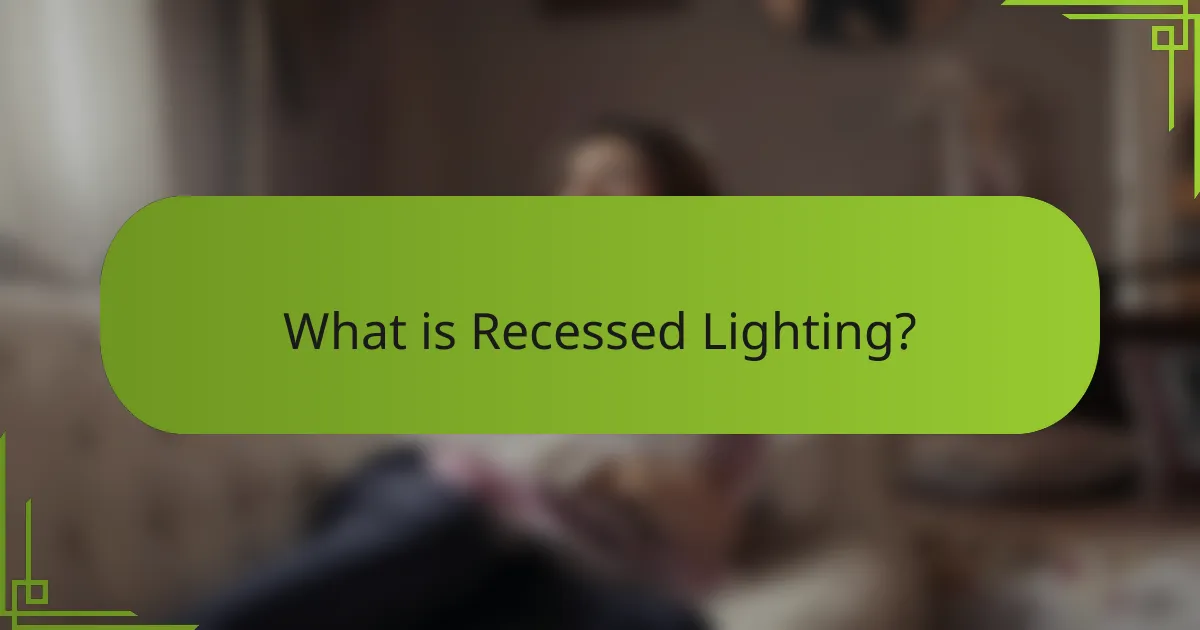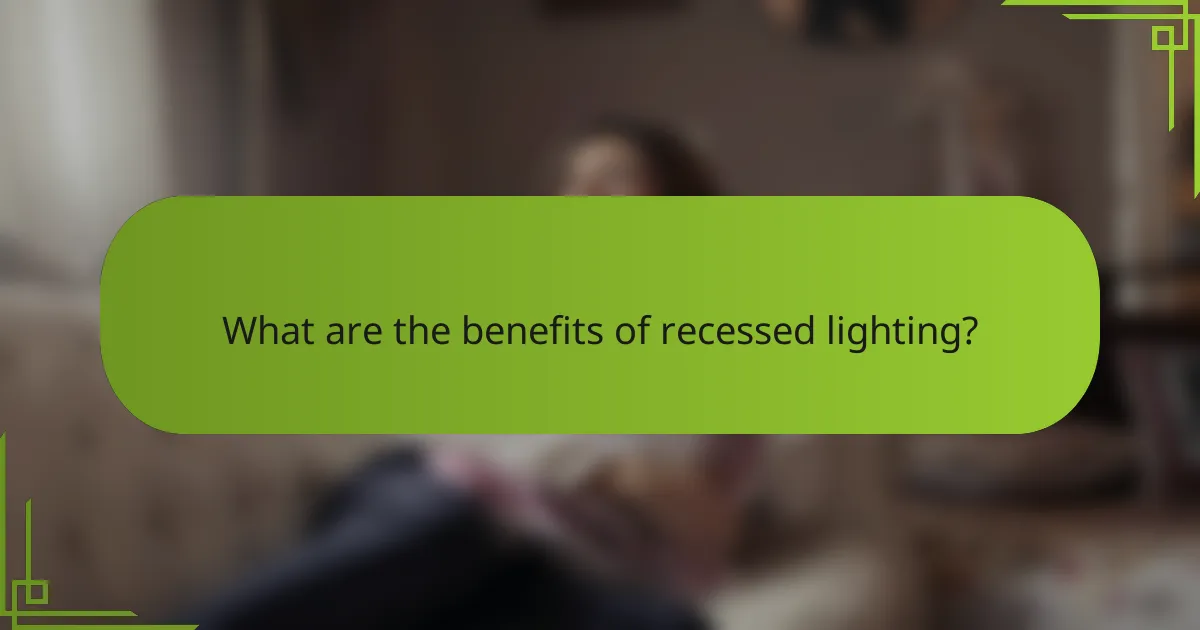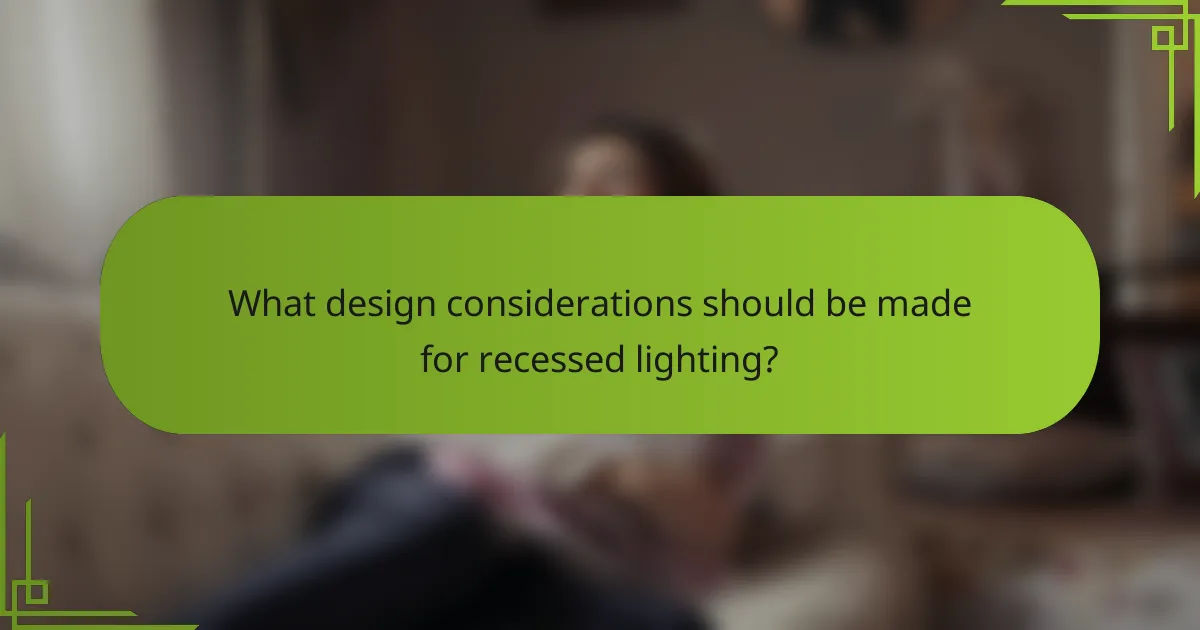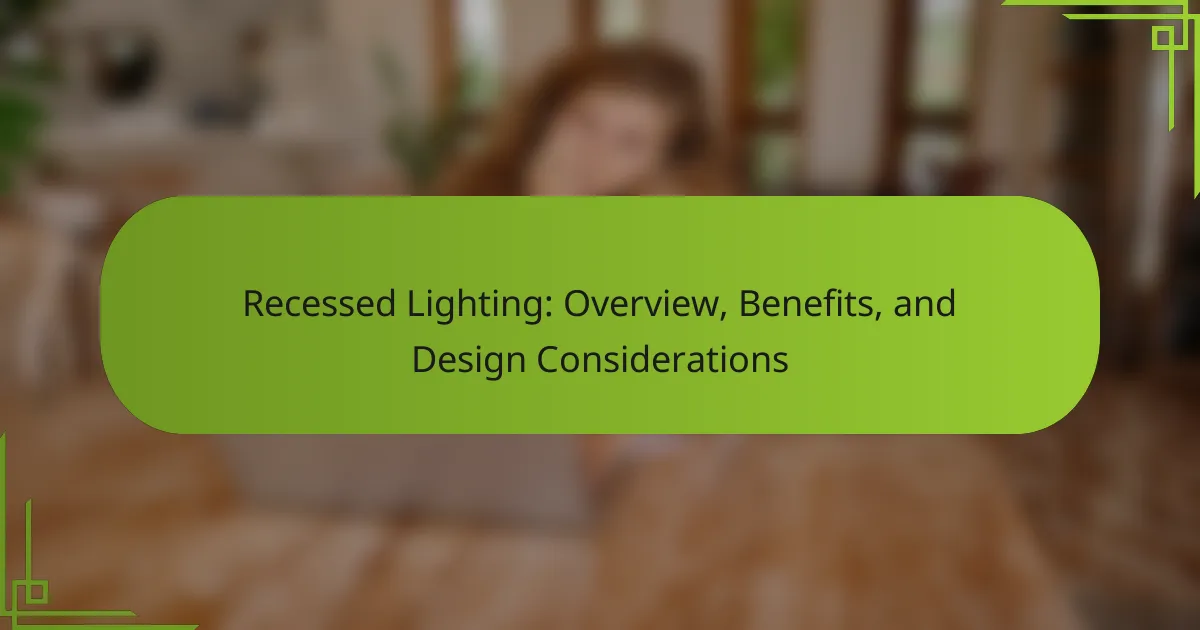
What is Recessed Lighting?
Recessed lighting is a type of light fixture installed into the ceiling. It creates a clean, streamlined appearance. This lighting is often used for ambient or task lighting. Recessed lights can be positioned in various configurations. They are available in different sizes and styles. The fixtures are usually equipped with bulbs that can be LED, incandescent, or fluorescent. Recessed lighting is popular in residential and commercial spaces. It provides effective illumination without occupying visual space.
How does recessed lighting work?
Recessed lighting works by installing light fixtures into the ceiling, creating a streamlined appearance. These fixtures consist of a housing, trim, and light bulb. The housing is mounted above the ceiling, while the trim is visible from below. Light is emitted downwards through the trim, illuminating the space. This design allows for a clean look and effective light distribution. Recessed lighting is often used for ambient, task, or accent lighting. The fixtures can be adjustable or fixed, depending on the desired effect. Proper installation and placement are essential for optimal lighting performance.
What are the key components of recessed lighting?
The key components of recessed lighting include the housing, trim, and light source. The housing is the metal or plastic enclosure that holds the light fixture. It is installed in the ceiling and provides support and protection for the electrical components. The trim is the visible part of the fixture that finishes the look and can vary in style and color. The light source refers to the type of bulb used, such as LED, incandescent, or fluorescent. Each component plays a crucial role in the functionality and aesthetics of recessed lighting systems.
What types of bulbs are used in recessed lighting?
Recessed lighting commonly uses LED, incandescent, and halogen bulbs. LED bulbs are energy-efficient and have a long lifespan, often lasting up to 25,000 hours. Incandescent bulbs provide warm light but consume more energy and have a shorter lifespan of about 1,000 hours. Halogen bulbs are a type of incandescent that offer brighter light and better color rendering, lasting around 2,000 hours. These bulb types are specifically designed to fit into recessed fixtures, ensuring optimal performance and aesthetics.
What are the common applications of recessed lighting?
Recessed lighting is commonly used in various applications to enhance illumination. It is frequently installed in residential spaces for general lighting. This includes living rooms, kitchens, and hallways. Recessed lighting is also popular in commercial environments. Offices and retail spaces utilize it for focused task lighting. Additionally, it is used in theaters and galleries to spotlight artwork. Its design allows for a clean aesthetic, minimizing visual clutter. The versatility of recessed lighting makes it suitable for both functional and decorative purposes.
Where is recessed lighting typically installed?
Recessed lighting is typically installed in ceilings. It is often used in living rooms, kitchens, and hallways. This type of lighting provides a clean and modern look. Recessed lighting can also be installed in bathrooms and bedrooms. It is commonly placed above workspaces for focused lighting. The fixtures are designed to be flush with the ceiling. This minimizes visual clutter and maximizes headroom. Proper placement enhances the overall aesthetic of a room.
How does recessed lighting enhance different spaces?
Recessed lighting enhances different spaces by providing focused illumination and a clean aesthetic. It allows for versatile lighting arrangements, which can highlight architectural features or artwork. The fixtures are installed into the ceiling, creating a streamlined look. This design minimizes visual clutter and maximizes ceiling height perception. Recessed lighting can be adjusted for brightness and color temperature, catering to various moods. It also improves functionality in areas like kitchens and workspaces by offering task lighting. Studies indicate that well-placed recessed lighting can increase a room’s perceived size and comfort. This versatility makes it suitable for residential and commercial environments.

What are the benefits of recessed lighting?
Recessed lighting offers several benefits. It provides a sleek, modern aesthetic by being installed into the ceiling. This design minimizes visual clutter and creates a clean look. Recessed lighting can enhance the ambiance of a room with adjustable brightness levels. It is also effective for task lighting in areas like kitchens and offices. Energy-efficient LED options are available, reducing electricity costs. Additionally, recessed lights can increase property value by improving overall design appeal. Studies show that well-lit spaces can positively affect mood and productivity.
How does recessed lighting improve aesthetics?
Recessed lighting enhances aesthetics by providing a clean, streamlined look to spaces. It eliminates bulky fixtures that can disrupt visual harmony. The subtle illumination creates a sense of spaciousness and depth. This type of lighting can highlight architectural features and artwork effectively. By directing light where needed, it minimizes shadows and enhances color perception. Recessed lighting also allows for flexible design options, adapting to various styles. According to a study by the American Society of Interior Designers, well-placed recessed lighting can significantly elevate a room’s overall appeal.
What design styles benefit from recessed lighting?
Recessed lighting is beneficial for several design styles. Modern design utilizes recessed lighting to create a clean, minimalist look. It enhances the sleek lines and open spaces typical of contemporary interiors. Traditional design also benefits, as recessed lighting can highlight architectural details without overwhelming the space. In industrial design, recessed fixtures complement raw materials and open layouts. Additionally, transitional design merges traditional and modern aesthetics, making recessed lighting a versatile choice. According to various design experts, recessed lighting is effective in enhancing ambiance and functionality across these styles.
How does recessed lighting create ambiance?
Recessed lighting creates ambiance by providing a subtle and even distribution of light. This type of lighting can enhance the overall atmosphere of a space. It reduces harsh shadows and creates a soft glow. Recessed fixtures can be directed to highlight specific areas or features. This versatility allows for personalized lighting effects. Dimmers can also be used with recessed lighting to adjust brightness levels. Lowering the light intensity can create a cozier environment. Studies show that well-placed recessed lighting can improve mood and comfort in living spaces.
What are the energy efficiency advantages of recessed lighting?
Recessed lighting offers significant energy efficiency advantages. It utilizes LED technology, which consumes up to 75% less energy than traditional incandescent bulbs. This results in lower electricity bills for homeowners and businesses. Recessed fixtures are often designed to focus light where needed, minimizing wasted illumination. Many recessed lights also come with dimming options, allowing users to adjust brightness and save energy. According to the U.S. Department of Energy, LED recessed lights have a lifespan of 15,000 to 50,000 hours, reducing the frequency of replacements. This longevity contributes to lower maintenance costs and waste. Overall, recessed lighting can enhance energy efficiency while providing effective illumination.
How do LED options compare to traditional bulbs in recessed lighting?
LED options are more energy-efficient and longer-lasting compared to traditional bulbs in recessed lighting. LEDs consume up to 80% less energy than incandescent bulbs. They typically last 15,000 to 50,000 hours, while traditional bulbs last about 1,000 hours. LEDs produce less heat, reducing cooling costs. They also provide instant brightness without warm-up time. Additionally, LED lights are available in various color temperatures, offering more design flexibility. Studies show that switching to LED can save homeowners significant amounts on energy bills over time.
What energy savings can be expected from recessed lighting?
Recessed lighting can provide significant energy savings, typically between 20% to 50% compared to traditional lighting options. This efficiency is largely due to the use of LED bulbs, which consume less electricity and have a longer lifespan. For instance, a standard LED recessed light can use about 10-15 watts, while an incandescent bulb may use 60 watts or more. Additionally, the targeted illumination of recessed lighting reduces wasted light, enhancing energy efficiency. According to the U.S. Department of Energy, switching to LED recessed lighting can save homeowners approximately $100 or more annually on energy bills. These savings can accumulate over time, making recessed lighting a cost-effective choice for energy-conscious consumers.

What design considerations should be made for recessed lighting?
Key design considerations for recessed lighting include placement, size, and trim style. Placement affects light distribution and can enhance room aesthetics. Proper spacing ensures even illumination and avoids dark spots. Size should match the room’s scale; larger rooms may require larger fixtures. Trim style influences the overall look and can be baffle, reflector, or adjustable. Light color temperature impacts ambiance; warmer tones create a cozy feel while cooler tones promote alertness. Additionally, consider the ceiling height; higher ceilings may require deeper fixtures for effective light spread. These factors collectively optimize functionality and design coherence in recessed lighting.
How do you determine the placement of recessed lights?
Determine the placement of recessed lights by assessing the room’s function and layout. Identify focal points such as artwork or furniture. Ensure adequate spacing between lights, typically 4 to 6 feet apart. Consider the ceiling height; higher ceilings may require more distance. Use a lighting plan to visualize placement. Test the layout with temporary markers to ensure effectiveness. Proper placement enhances both aesthetics and functionality.
What factors influence the spacing of recessed lighting?
The spacing of recessed lighting is influenced by several key factors. These factors include the height of the ceiling, the wattage of the bulbs, and the intended purpose of the lighting. Ceiling height affects how far apart fixtures should be placed to achieve even illumination. Higher ceilings typically require wider spacing. The wattage determines the light output, which influences how much area can be effectively lit. For example, higher wattage bulbs may allow for greater spacing between fixtures. Additionally, the purpose of the lighting, such as general illumination versus task lighting, impacts spacing decisions. For general lighting, fixtures may be spaced further apart, while task lighting requires closer spacing to ensure adequate brightness. Lastly, the layout of the room and any architectural features also play a role in determining optimal spacing.
How does ceiling height affect recessed lighting design?
Ceiling height significantly impacts recessed lighting design. Higher ceilings require different fixture placement to ensure adequate light distribution. For ceilings over 10 feet, fixtures should be spaced further apart to avoid shadows. Conversely, lower ceilings necessitate closer fixture placement to maximize light output. The beam angle of the recessed lights also plays a role; narrow beams may be better for high ceilings, while wider beams suit lower ceilings. Additionally, the overall aesthetic is affected; higher ceilings can accommodate larger fixtures for dramatic effects. Properly considering ceiling height ensures optimal functionality and visual appeal in recessed lighting design.
What are the different trim styles available for recessed lighting?
The different trim styles available for recessed lighting include baffle, reflector, and adjustable trims. Baffle trims feature a ribbed interior that helps reduce glare and improve light diffusion. Reflector trims have a shiny, smooth surface that enhances brightness and directs light downward. Adjustable trims allow for directional lighting, making them ideal for highlighting specific areas or objects. Other styles include wall wash trims, which create an even wash of light on walls, and shower trims, designed for wet locations. Each trim style serves a unique purpose and contributes to the overall aesthetic of the space.
How does trim style impact light distribution?
Trim style significantly impacts light distribution in recessed lighting. Different trim styles control the direction and intensity of light emitted. For example, baffle trims reduce glare by softening the light, while reflector trims enhance brightness by directing light downward. The choice of trim affects the spread of light across a space. Adjustable trims allow for directional lighting, making them ideal for task-oriented areas. In contrast, fixed trims provide a more uniform light distribution. Studies indicate that the right trim can enhance room ambiance and functionality. The selection of trim style is crucial for achieving desired lighting effects.
What are the aesthetic considerations for trim selection?
Aesthetic considerations for trim selection in recessed lighting include style, color, and finish. The style should complement the overall design theme of the space. Common styles include modern, traditional, and minimalist. Color plays a crucial role in blending or contrasting with the ceiling and walls. Popular finishes include matte, gloss, and metallic, each affecting light reflection. The trim shape, such as round or square, also influences the visual appeal. Size is important; larger trims can create a bold statement, while smaller trims offer a subtle look. The choice of materials can enhance durability and aesthetics. These factors collectively impact the overall ambiance and functionality of the lighting design.
What tips should be followed for installing recessed lighting?
Choose the right placement for recessed lighting. Ensure fixtures are evenly spaced for optimal illumination. Use a layout that complements the room’s function. Consider the height of the ceiling when selecting fixture types. Verify that the electrical wiring meets local codes. Use a dimmer switch for adjustable lighting levels. Select LED bulbs for energy efficiency and longevity. Test the lighting before final installation to ensure satisfaction.
How can you ensure proper electrical safety during installation?
To ensure proper electrical safety during installation, always turn off power at the circuit breaker. This prevents accidental electrocution or short circuits. Use insulated tools when working with electrical components. Insulation minimizes the risk of shock. Verify that all wiring is up to code and suitable for the installation. Local electrical codes provide guidelines for safe practices. Ensure that connections are secure and use wire nuts for splicing. Loose connections can lead to overheating and fires. Additionally, install fixtures that are rated for the type of insulation present. This prevents overheating and potential fire hazards. Finally, conduct a thorough inspection after installation before restoring power. This ensures all safety measures are properly implemented.
What common mistakes should be avoided when installing recessed lighting?
Common mistakes to avoid when installing recessed lighting include improper placement, inadequate spacing, and using the wrong type of bulb. Improper placement can lead to uneven lighting and shadows. Inadequate spacing can result in a dimly lit area or excessive brightness in certain spots. Using the wrong type of bulb may affect the color temperature and energy efficiency. Additionally, neglecting to consider ceiling height can impact light distribution. Failing to account for insulation can create fire hazards. Not using a dimmer switch can limit flexibility in lighting control. Finally, overlooking the electrical requirements can lead to safety issues.
Recessed lighting is a ceiling-installed light fixture that provides a clean, streamlined appearance and is commonly used for ambient, task, or accent lighting. This article explores the key components of recessed lighting, including housing, trim, and bulb types, as well as its common applications in residential and commercial spaces. It highlights the benefits of recessed lighting, such as energy efficiency, aesthetic enhancement, and improved functionality, while also addressing design considerations like placement, spacing, and trim styles. Additionally, the article provides installation tips and safety measures to ensure effective and safe use of recessed lighting.
